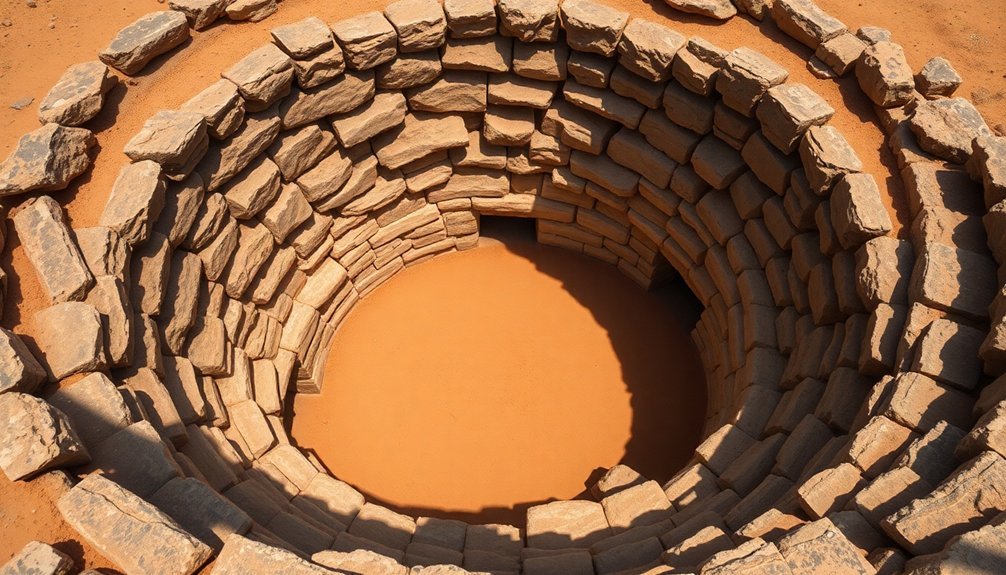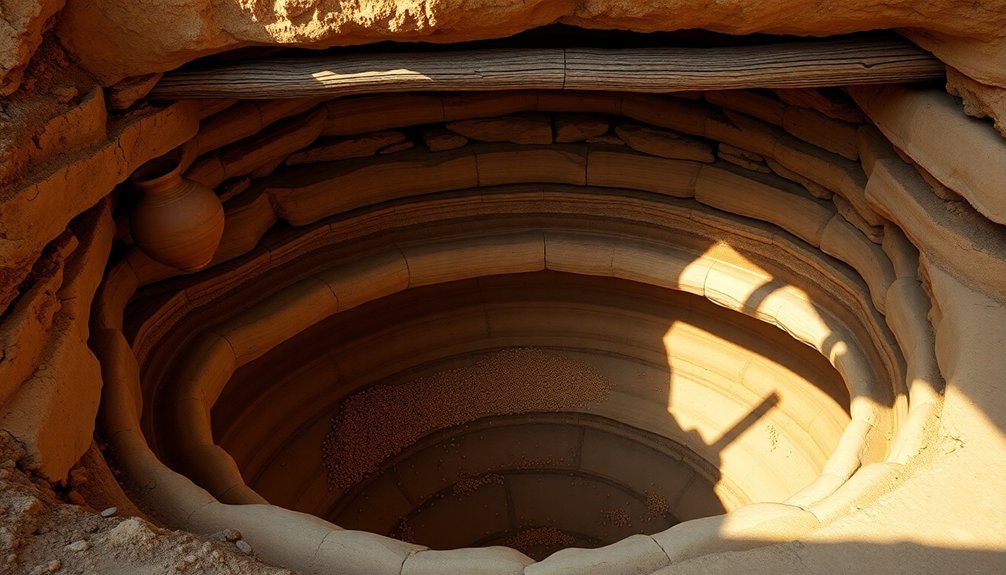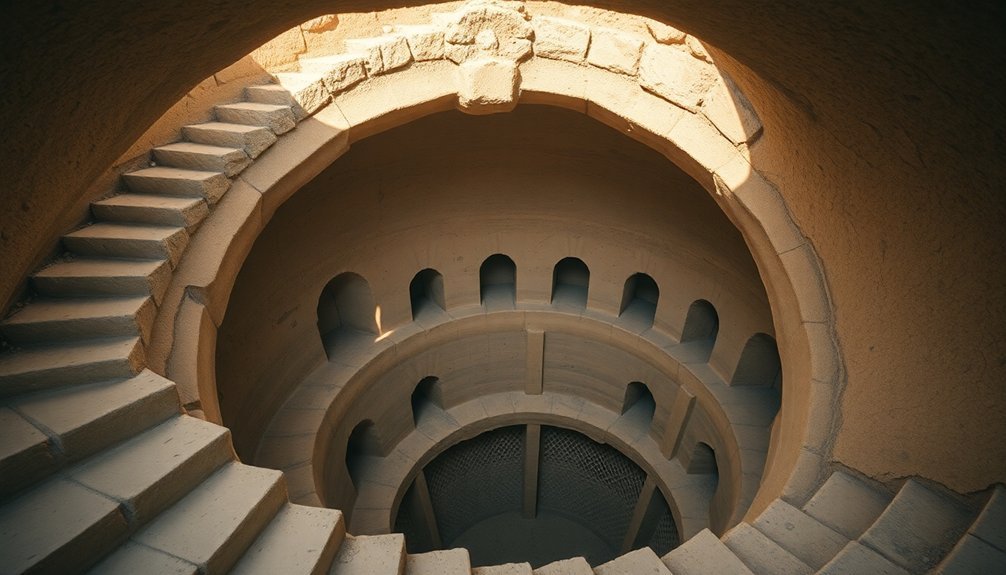Ancient civilizations mastered pit storage across diverse climates, from scorching deserts to frozen tundra. You'll find desert peoples used rock-lined caches and sealed ceramic vessels, while Arctic communities created ice cellars with larch-reinforced walls and oily clay coatings. In temperate Britain, they built beehive-shaped pits that trapped carbon dioxide for grain preservation, while Mediterranean cultures developed sophisticated ventilation systems. Each region's methods reflected ingenious adaptations to local conditions, using natural materials like clay, straw, and ice. These time-tested techniques hold valuable lessons for modern food preservation and sustainability.
Desert Rock-Lined Cache Systems

The ancient desert rock-lined cache systems served as essential storage solutions for aboriginal peoples in California's desert regions. You'll find these subterranean pits strategically built in sheltered locations, where they helped communities store food, equipment, and raw materials securely. These unique features demonstrate hunter-gatherer organizational complexity.
These caches played an important role in helping tribes survive seasonal food shortages and manage their resources effectively. Archaeological excavations at Indian Hill Rockshelter in southeastern California have revealed extensive evidence of these storage systems.
You can see similar features throughout California's desert regions, though many traditional excavations have overlooked these nonportable structures in favor of studying portable artifacts. The caches typically appear near permanently occupied villages, particularly in canyon areas.
When you compare these systems to other regions, you'll notice similarities with the Colorado Plateau's cache pits, particularly during early Anasazi times.
However, as time progressed, these rock-lined caches gave way to new storage technologies. You'll find that sealed ceramic ollas, large seed jars, and elevated granary structures eventually replaced many of these traditional underground storage systems during the Early Ceramic period (AD 50 to 500).
Moisture Control in Temperate Pits
Mastering moisture control in temperate storage pits required sophisticated engineering techniques from ancient peoples.
You'll find their methods relied heavily on natural materials like clay, mud, and cow dung to create waterproof barriers that protected valuable grain stores from the region's frequent rainfall and ground moisture.
The pit builders developed a multi-layered approach to moisture control that you can still see in archaeological sites today.
They'd first construct flask-shaped or conical pits with gently sloping walls to prevent collapse, then apply a thick plaster mixture of clay mud reinforced with fiber and dung. Archaeological evidence shows these pits were often fire-hardened for durability.
You'll notice they've created an almost pottery-like consistency that effectively blocks moisture penetration.
Here are three key visual elements you'd spot in a well-preserved temperate pit:
- A carefully sealed top using flat stones embedded in mud, creating an airtight barrier
- Walls with a smooth, sealed surface from repeated applications of clay-dung plaster
- A polyethylene-like waterproof layer created by multiple coats of processed clay and organic materials
Modern experiments have shown these methods were remarkably effective, allowing grain storage for up to a year when properly maintained.
Arctic Ice Storage Techniques

You'll find ancient Arctic storage pits were marvels of engineering, featuring larch-reinforced walls coated with oily clay and strategic board coverings to protect against predators.
These pits took advantage of natural cooling mechanisms by utilizing permafrost and ice cellars dug into northern slopes, while incorporating clever drainage systems made from birch and larch bark. Much like how Arctic sea ice regulates Earth's temperature, these storage pits maintained steady cold conditions year-round.
To preserve meat effectively, you'd stack fish in layers with ice chips, using pyramidal arrangements that allowed water to flow away from the stored food while maintaining consistent cold temperatures through passive ventilation.
Permafrost Pit Design Features
Throughout Arctic regions, permafrost pit storage systems relied on sophisticated engineering and natural materials to preserve food in harsh conditions. You'll find these ingenious structures built into northern slopes of steep banks, where they maximize natural cooling potential.
The design prioritizes sediment-rich frozen soil over complete ice lenses, making tunnel maintenance more manageable while ensuring long-term stability. The structural integrity of these pits depends on carefully selected materials and precise construction techniques.
You'll see wooden reinforcements throughout, with larch poles supporting the floor and walls. A combination of birch and larch bark creates essential drainage systems, while oily clay coatings protect the pit walls.
Here's what makes these storage pits remarkably effective:
- Layered insulation using peat moss bags, deer skins, and tarpaulins to maintain consistent temperatures
- Strategic placement of ice chips and birch branch bundles to fill gaps and prevent warm air infiltration
- Specialized fumigation chambers using juniper or larch shavings to preserve fish quality
The design incorporates separate ice storage pits nearby, ensuring a continuous supply of cooling material for year-round food preservation.
Natural Cooling Mechanisms
Several ingenious natural cooling mechanisms enabled Arctic communities to preserve ice year-round without modern technology. They'd harvest ice from rivers and lakes during the winter months, when temperatures were at their lowest, and store it in specially designed ice houses or pits.
You'll find that these storage solutions relied on basic but effective principles of insulation and temperature control.
The key to successful ice preservation was the careful layering of insulating materials. If you'd looked inside these storage pits, you'd have seen ice blocks carefully packed with straw or sawdust. These natural insulators prevented heat transfer and kept the ice frozen even during warmer months.
The design wasn't unique to the Arctic – you can trace similar methods across different cultures, from Mediterranean regions to South America.
The effectiveness of these cooling mechanisms depended heavily on proper timing and technique. You'd need to harvest the ice at peak winter conditions and guarantee the storage pits were properly prepared with insulation.
This method proved so reliable that wealthy Europeans later adopted it, building ice houses on their estates to maintain year-round ice supplies.
Meat Preservation Methods
Arctic communities developed remarkably effective meat preservation techniques using natural ice and permafrost storage. They'd dig deep cellars into the permafrost, framing them with whalebone and driftwood to create sustainable cold storage spaces.
You'll find these ingenious structures still in use across communities like Nuiqsut, Barrow, and Kaktovik, where they're essential for preserving whale meat and maktak.
These traditional storage methods relied on simple but effective mechanical systems. You'd use a block pulley system, supported by driftwood poles arranged in a teepee formation, to lower and raise heavy meat stores. The permafrost provided consistent temperatures perfect for preservation, while additional ice houses enhanced storage efficiency.
Here's what you'd typically see in a traditional Arctic ice cellar:
- Whale bones forming sturdy structural supports, weathered by time and gleaming with frost
- Driftwood poles creating a distinctive teepee-shaped entrance, often draped with snow
- Block and tackle systems hanging from central beams, ready to move heavy cuts of meat
Today, you'll find these traditional methods facing new challenges as climate change causes permafrost thaw and erosion, forcing communities to adapt their ancient preservation techniques.
Ancient British Grain Preservation
You'll find ancient British grain storage cleverly engineered through two main systems: beehive-shaped underground pits with hermetic seals and raised four-post granary structures.
The beehive pits' design allowed for long-term preservation by naturally trapping carbon dioxide, while the elevated granaries kept daily-use grain ventilated and safe from pests.
These complementary storage methods show how Iron Age Britons mastered both short-term and long-term grain preservation, using natural physics and smart architecture to protect their harvests.
Beehive Pit Design Features
Ancient Britons mastered the art of grain preservation through ingeniously designed beehive-shaped storage pits. You'll find these remarkable structures had a distinctive narrow top that broadened into a wider base, with sides that were either vertical or slightly inclined.
This clever design wasn't just for show – it made sealing the pits easier and prevented surface water from seeping in, protecting the valuable grain stores within.
If you'd examined these pits during the Iron Age, you'd have noticed they were often integrated into house structures or carefully positioned within settlement sites. The design created an impressive self-preserving environment that you couldn't achieve with above-ground storage methods.
- Picture a giant beehive turned upside down and buried in the earth, filled to the brim with golden grain
- Imagine the careful sealing process, as workers cap the narrow opening to create an airtight chamber
- Visualize the internal transformation as oxygen depletes and carbon dioxide builds up, naturally preserving the grain
The effectiveness of these pits has been proven through both archaeological findings and modern experiments, showing they could preserve grain for more than a year while maintaining its quality for both consumption and seeding.
Four-Post Granary Systems
While underground storage pits proved effective for long-term preservation, Iron Age Britons also developed an ingenious above-ground solution: the four-post granary system. You'll find these structures identified by four postholes arranged in a square or rectangular pattern, supporting an elevated platform that kept grain stores well-ventilated and dry.
| Feature | Function |
|---|---|
| Elevated Design | Promotes airflow and prevents moisture damage |
| Whole Grain Storage | Protects kernels from granary weevils |
| Daily Access | Allows easy retrieval for processing |
Unlike Roman storage methods, you'll notice these granaries were designed for storing unprocessed grain with husks intact. This practical approach meant you'd need to process small amounts daily, as described by Diodorus, but it provided superior protection against pests. The system proved so effective that you can still see similar designs in modern-day Galicia's hórreos.
Archaeological evidence from sites like Danebury Hillfort shows these granaries were typically positioned within settlements, creating centralized storage areas. You'll find they worked in tandem with storage pits, offering a thorough grain management system that supported year-round food security for Iron Age communities.
Carbon Dioxide Storage Benefits
In a remarkable display of early scientific understanding, Iron Age Britons harnessed the natural process of grain respiration to create effective underground storage systems. When you'd seal grain in these underground pits, a fascinating chemical reaction occurred – the grain's natural respiration consumed oxygen and produced carbon dioxide, creating a self-preserving environment.
This natural process offered several key benefits that you'll find particularly clever. The carbon dioxide-rich atmosphere effectively prevented grain spoilage and killed off unwanted pests. While some grain near the pit's edges might spoil due to trapped moisture, you could easily discard these portions, leaving the bulk of your harvest in perfect condition.
To visualize the effectiveness of this storage method, consider these key features:
- Beehive-shaped pits with narrow tops that you'd seal with straw or dung
- A naturally occurring oxygen-free zone that preserved grain for months or years
- A self-sterilizing environment that eliminated the need for additional preservatives
Archaeological evidence from sites like Danebury Hillfort and experimental reconstructions at Butser Ancient Farm have proven this method's remarkable effectiveness.
Mediterranean Climate Storage Solutions

Growing climate challenges in the Mediterranean region have shaped both historical and modern storage solutions. You'll find that ancient civilizations developed ingenious methods to cope with the area's distinct climate patterns, from underground pits to sophisticated granaries along the Nile River.
The Romans' innovative horrea stand out as particularly effective climate-controlled storehouses. You'd have seen these bustling facilities managing everything from olive oil to exotic spices, with guards monitoring secured chambers and detailed cataloging systems tracking every item.
Today's Mediterranean storage solutions combine historical wisdom with modern technology. You're looking at facilities that use digital booking platforms, biometric security, and advanced climate monitoring systems.
These contemporary solutions don't just address personal storage needs – they're part of a broader strategy to manage resources sustainably in a region facing increased anthropogenic pressures and rapid climate change.
Whether you're storing business inventory or household items, you'll find that modern facilities maximize vertical space while maintaining accessibility.
They're designed to balance various needs, from domestic storage to industrial requirements, all while considering the region's unique environmental challenges.
Monsoon Region Preservation Methods
Monsoon regions faced unique preservation challenges that required different approaches from their Mediterranean counterparts. In these humid climates, you'll find that ancient civilizations developed sophisticated preservation methods to combat food spoilage during wet seasons.
Four main techniques dominated monsoon preservation: drying, fermenting, curing, and pickling. When you couldn't rely on consistent sunlight, you'd use still houses with fire to dry your foods. Fermentation wasn't just about preservation – it actually enhanced your food's nutritional value by creating additional vitamins through microbial action.
Picture these common scenes from monsoon regions:
- Rows of still houses with smoke rising from their roofs, filled with hanging fruits and vegetables slowly drying in the heated air.
- Clay pots of fermenting foods bubbling away, transforming simple ingredients into nutrient-rich preserved goods.
- Baskets of salt-cured fish and meat hanging from rafters, protected from the humid air that would otherwise cause rapid spoilage.
These preservation methods weren't just practical – they were essential survival techniques. You'd often combine multiple methods, like drying and salting, to guarantee your food would last through the challenging monsoon seasons.
Advanced Iranian Cooling Systems

Through centuries of innovation, ancient Iranians developed remarkable cooling systems that revolutionized desert living. Their most notable inventions include the windcatcher (Bâdgir) and ice house (Yakhchal), which demonstrate an advanced understanding of thermodynamics and architectural engineering.
You'll find windcatchers, dating back to the 8th century AD, particularly prevalent in cities like Yazd. These tower-like structures capture wind and direct it downward, creating natural ventilation that displaces hot air while bringing in cooler air.
They're so effective that you don't need electricity to maintain comfortable indoor temperatures year-round.
The Yakhchal system's ingenuity lies in its ice production and storage methods. You'd be amazed to learn that these structures produced ice using night sky radiation during clear winter nights.
The ice was then stored in deep pits, layered with insulating straw, within thick-walled domed structures. Water for ice production came from qanat systems, underground aqueducts that transported water efficiently.
Today, these sustainable cooling solutions are being adapted globally, offering environmentally friendly alternatives to modern air conditioning systems in hot climates.
Indigenous American Storage Innovations
Ingenuity shaped Native American food storage systems across diverse regions and climates. You'll find evidence of this sophistication in both underground and aboveground storage methods, each carefully designed to preserve essential food supplies through changing seasons.
Underground pits, reaching depths of 6 to 8 feet, were masterfully engineered using natural materials. You'd see these pits lined with clay, bark, or woven reed mats, while fire-cleaning techniques kept them sanitary for repeated use.
Above ground, separate structures housed specific items like maple sugar and wild rice, with raised corncribs protecting valuable grain stores.
Picture these three distinct preservation scenes:
- Elders teaching youth to construct storage pits, carefully layering protective materials while sharing generations of wisdom.
- Families working together to dry strips of buffalo meat in the sun, children turning the pieces while elderly members keep watch.
- Community members gathering around smoking racks, using green branches to preserve fish for winter months.
These methods weren't just about food storage – they represented a complex system of knowledge transfer, combining practical preservation techniques with community involvement and sustainable resource management.
Frequently Asked Questions
How Did Ancient Civilizations Determine the Optimal Depth for Storage Pits?
You'll find ancient people determined pit depths through trial and error, considering grain quantity, climate protection, and soil conditions. They'd test different depths until finding what worked best for their storage needs.
What Tools Were Commonly Used to Excavate and Maintain Storage Pits?
You'll need digging sticks, stone or bone shovels, and wooden scrapers to excavate storage pits. For maintenance, you'd use brushes and smaller tools to clean walls and remove debris regularly.
Did Different Social Classes Have Access to Different Types of Storage Methods?
You'll find that higher social classes typically had access to more sophisticated storage methods like granaries and dedicated buildings, while lower classes often relied on simpler solutions like basic pit storage and communal facilities.
How Did Ancient Societies Handle Food Distribution From Communal Storage Facilities?
You'll find ancient societies used communal granaries with strict distribution systems. They'd typically have leaders or priests oversee rationing, often based on social status, labor contributions, and household needs in the community.
What Rituals or Ceremonies Were Associated With Pit Storage Construction?
You'll find ancient societies performed specific rituals when building storage pits, including placing sacred offerings in postholes, conducting ceremonial blessings before construction, and treating depositories with reverence during their use and abandonment.
In Summary
You've seen how ancient civilizations mastered pit storage across diverse climates, from desert to arctic regions. They've left us invaluable lessons about working with natural materials and local conditions. Whether it's rock-lined desert caches or ice-packed arctic pits, you'll find these time-tested methods still relevant today. You can adapt these techniques to modern food preservation, proving our ancestors' ingenuity stands the test of time.





Leave a Reply